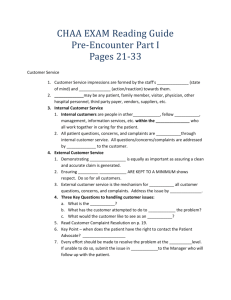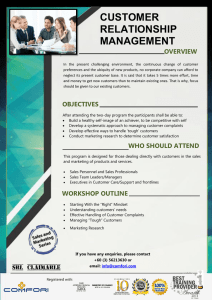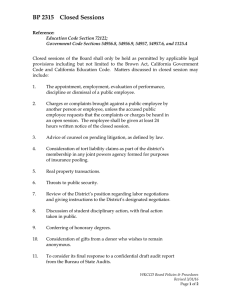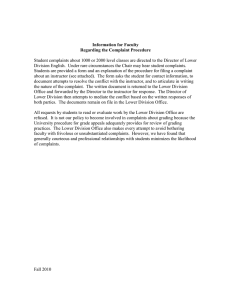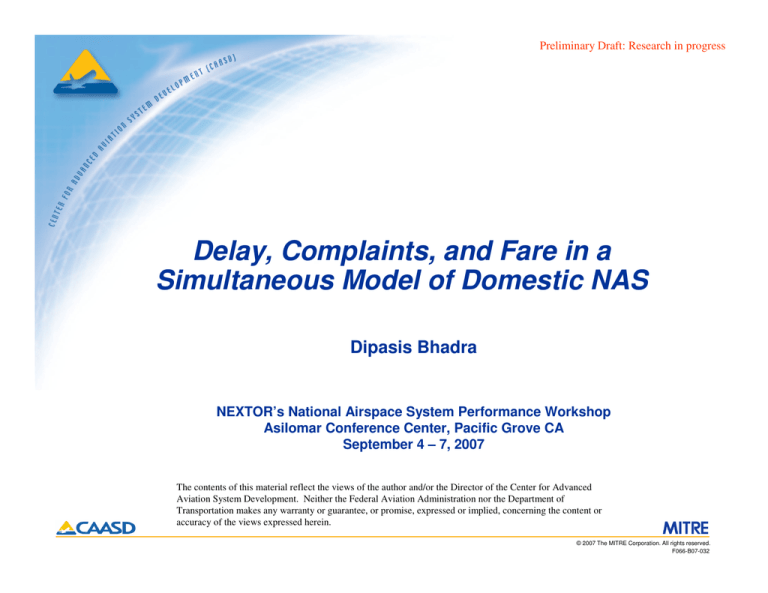
Preliminary Draft: Research in progress
Delay, Complaints, and Fare in a
Simultaneous Model of Domestic NAS
Dipasis Bhadra
NEXTOR’s National Airspace System Performance Workshop
Asilomar Conference Center, Pacific Grove CA
September 4 – 7, 2007
The contents of this material reflect the views of the author and/or the Director of the Center for Advanced
Aviation System Development. Neither the Federal Aviation Administration nor the Department of
Transportation makes any warranty or guarantee, or promise, expressed or implied, concerning the content or
accuracy of the views expressed herein.
© 2007 The MITRE Corporation. All rights reserved.
F066-B07-032
Preliminary Draft: Research in progress
Breaking All Records in Delays
2
© 2007 The MITRE Corporation. All rights reserved.
F066-B07-032
Preliminary Draft: Research in progress
Why Aren’t They Complaining More?
Nature of Delays: Delay and Complaints
70,000
60,000
Delays
Expected Relationship Between Delays and Complaints
3,000
2,500
50,000
40,000
1,500
30,000
Total Complaints
Total No. of Delays
2,000
“We are
surprised
people aren't
complaining
more”
1,000
20,000
0
Jan-97
500
No. of Delayeds
Total Complaints
10,000
Oct-97
Jul-98
Apr-99
Jan-00
Oct-00
Jul-01
Apr-02
Prof. John Hansman,
Aeronautics and
Astronautics, MIT; quoted
in Why the Skies Have
Gotten Crowded, Sarah
Nassauer, July
broken,
a 21,
2007; Page A5; Wall Street
• Is the old relationship
0
Oct-03 Jul-04 Apr-05 Jan-06 Oct-06
paradigm shift? Or, is this
a
Complaints
Journal.
temporary phenomenon?
Jan-03
Data Sources:
Monthly total delay: OPSNET count of total number of delayed flights;
Total complaints: Composite of airline passengers’ complaints from
Airline Consumer Report. See the last page for definition and sources of all
3
variables
© 2007 The MITRE Corporation. All rights reserved.
F066-B07-032
Preliminary Draft: Research in progress
Passengers Who Are Delayed, Average Time
of the Delayed Flights Seems to Have Not
Changed
60
5
50
4
40
3
Complaints per 100,000 enplanement 30
Average Time of Delays
2
20
1
10
0
Jan-97
4
Average Time of Delay
Complaints per 100,000 Enplanement
Nature of Delays: Unit Complaints and Average Time
6
0
Oct-97
Jul-98
Apr-99
Jan-00
Oct-00
Jul-01
Apr-02
Jan-03
Oct-03
Jul-04
Apr-05
Jan-06
Oct-06
© 2007 The MITRE Corporation. All rights reserved.
F066-B07-032
Preliminary Draft: Research in progress
We Complain More If We Pay More:
We (Expect To) Get What We Pay For
Real Yield and Complaints
6
14.00
12.00
Complaints per 100,000 Enplanements
Yield (cents/RPM)
Average: 10.80 cents
Jan. ’97 – Feb., ‘01
Threshold and
event specific to
this time period
4
10.00
Average: 8.26 cents
Mar, ‘01 – Oct., ‘06
8.00
3
6.00
Yield (Cents/RPM)
Complaints per 100,000 Enplanements
5
2
4.00
Comair
software
glitch: Jan ‘05
1
2.00
0
Jan-97
0.00
Oct-97
Jul-98
Apr-99
Average real yield: RPM adjusted for distance and
5
normalized
to 1990 CPI; Air Transport Association
Jan-00
Oct-00
Jul-01
Apr-02
March, ‘01 Sept, ‘01
Jan-03
Oct-03
Jul-04
Apr-05
Jan-06
Oct-06
© 2007 The MITRE Corporation. All rights reserved.
F066-B07-032
Preliminary Draft: Research in progress
Passenger and Complaints: Declining
Complaints Are Even More Striking With
Increasing Number of Passengers
Passenger and Complaints
70,000,000
3,000
60,000,000
2,500
2,000
40,000,000
No. of Domestic Pax
Total Complaints
1,500
30,000,000
Total Complaints
No. of Domestic Passengers
50,000,000
1,000
20,000,000
500
10,000,000
0
Jan-97 Oct-97
6
0
Jul-98
Apr-99 Jan-00 Oct-00
Passenger data: T100 segment, Form 41; BTS/DOT
Jul-01
Apr-02 Jan-03 Oct-03
Jul-04
Apr-05 Jan-06 Oct-06
© 2007 The MITRE Corporation. All rights reserved.
F066-B07-032
Preliminary Draft: Research in progress
Recap and Key Empirical Question
• Weather continues to remain the single major factor behind
delays
• However, the changing relationship between delay and
complaints can not be completely understood without
accounting for fare and passenger responses
• Between the two periods (Jan, 1997 – Feb. 2001; and Mar, 2001
– Oct., 2006), average real fare has fallen 23% and average
number of domestic passengers (by US carriers) have
increased by 7%.
• Empirical Question: Is the falling fare compensating
passengers from expecting too much quality leading to less
complaints?
7
© 2007 The MITRE Corporation. All rights reserved.
F066-B07-032
Preliminary Draft: Research in progress
A Proposed Analytical Framework to
Capture Fare and Delay Trade-Off
fare
delay
fare
Domestic
passengers/trips
fare
Complaints
delay
Complaints
Compensated demand-delay function: Compensated by lower fare for increased delays but less complaints
8
© 2007 The MITRE Corporation. All rights reserved.
F066-B07-032
Preliminary Draft: Research in progress
Empirical Framework Determining Fare,
Complaints and Delay Simultaneously
• Inverse demand function: Market demand facing
airlines
– Fare = f (domestic passengers; composite effects; εf)
• H0: Domestic passengers (-); composite effects consisting of
March, 2001 economy slowdown and 9/11 (-)
• Complaints function: Passengers’ trade-off (fare and
delay) that results in optimal number of complaints
– Complaints = f (Fare; Delay; Domestic departures by US
carriers; εχ)
• H0: fare (?); delay (?); domestic departures (?)
• Delay function: NAS operations result in delay
– Delay = f(Terminal volume delays; Center volume delays,
Actual block time; Summer dummy; εδ)
• H0: Terminal volume delays (+); center volume delays (+); actual
block time (+); summer dummy (+)
9
© 2007 The MITRE Corporation. All rights reserved.
F066-B07-032
Preliminary Draft: Research in progress
Methodology and Data
(Definitions and sources are at the last page)
•
Demand function data
– Monthly passenger data from the Bureau of Transportation Statistics (BTS)
of the Department of Transportation (DOT); and Air Transportation
Association for yield information
•
Complaints function data
– Air Travel Consumer Reports: DOT
•
Delay function data
– FAA/APO’s ASPM
•
Methodology: Non-linear Iterative Simultaneous Equation System
– Ordinary least squares methodology suffers from simultaneity bias (e.g.,
endogenous delay may depend on εχ)
– Fare, delay, and complaints are, in fact, determined simultaneously
– Iterative process begins with OLS parameter estimates and improves the
estimation in subsequent steps
10
© 2007 The MITRE Corporation. All rights reserved.
F066-B07-032
Preliminary Draft: Research in progress
Statistical Model:
Empirical Results for Logarithmic Specification
Inverse Demand
Function
Complaints
Function
Delay
Function
11
© 2007 The MITRE Corporation. All rights reserved.
F066-B07-032
Preliminary Draft: Research in progress
Estimated Results Confirm the
Proposed Analytical Framework
yield
delay
yield
Domestic
passengers/trips
yield
12
Complaints
delay
Complaints
Effect of negative shocks (e.g., recession of ’01, 9/11) on yield, complaints and delay
© 2007 The MITRE Corporation. All rights reserved.
F066-B07-032
Preliminary Draft: Research in progress
Comfort for Lower Fares:
Nature of Trade-Off
• “Crowding reflects the success of deregulation, not its
failure. Competition in the unregulated market has proved
to the satisfaction of the carriers that most travelers are
willing to sacrifice comfort for lower fares.”
– Alfred Kahn, the last chairman of the Civil Aeronautics Board
before deregulation; Why the Skies Have Gotten Crowded, Sarah
Nassauer, July 21, 2007; Page A5; Wall Street Journal
• Furthermore, access to technology (e.g., wifi, blackberry)
has made the delayed time utilized more efficiently than
before leading to less complaints
13
© 2007 The MITRE Corporation. All rights reserved.
F066-B07-032
Preliminary Draft: Research in progress
Concluding Comments
•
Congress is considering several bills mandating airline
passengers’ rights, including
– Right to disembark when an aircraft is sitting on the tarmac more than
3 hours
– Right to food, water and clean bathrooms if stranded on the tarmac
– Right to receive accurate and timely information about delayed flights,
diverted and canceled flights
14
•
The airlines oppose mandated bill of rights. After all, legislations
lead to increased cost. Given the market competitiveness, this may
further put pressure on the bottom line and/or fare
•
Depending on the elasticities of demand and supply, fare may
increase and/or decrease resulting in more (less) complaints in the
future
•
A paper will be shortly available giving the analytical and empirical
framework, results and other details
© 2007 The MITRE Corporation. All rights reserved.
F066-B07-032
Preliminary Draft: Research in progress
Data and Sources
Passengers
U.S. Carriers
Non U.S. Carriers
All Carriers
Domestic
International
System Wide
Departures
T100 Market
http://www.transtats.bts.gov/databases.asp?Mode_ID=1&Mode_Desc=Aviation&Subject_ID2=0
Categories are the same as those for Passengers but the metric accounts for flights as opposed to individual passengers
Fares
Air Trnaport Association
http://www.airlines.org/economics/finance/monthly+yields.htm
Data reflects aggregated monthly data for the following U.S. airlines: Alaska (AS), America West (HP), American (AA), Braniff (BN),
Continental (CO/CS), Delta (DL), Eastern (EA), Northwest (NW), Pan Am (PA), Piedmont (PI), Republic (RC), Trans World (TW), United (UA), US Airways (US), Western (WA)
DOMESTIC
¢/RPM
CPI
Value
% Chg. YOY from 1990
Normal ¢/RPM 1990 Value
15
T100 Market
http://www.transtats.bts.gov/databases.asp?Mode_ID=1&Mode_Desc=Aviation&Subject_ID2=0
U.S. air Carriers
Foreign air carriers
Sum of U.S. and Non U.S. Carriers
both origin and destination airports are located within the boundaries of the United States and its territories
at least one point of service is in the United States or one of its territories.
Sum of Domestic and International
average cents per revenue passenger mile for domestic flights
consumer price index value
percent change from current year compared to CPI value at 1990
¢/RPM normalized to value equivalent to 1990 value of money
Complaints
http://airconsumer.ost.dot.gov/reports/index.htm
Complaints are against U.S. airlines
Flight Problems
Oversales
Ticketing/Boarding
Fares
Refunds
Baggage
Customer Service
Disability
Smoking
Advertising
Credit
Tours
Discrimination
Animals
Other
Total Complaints
System Wide Passengers
Cancellations, delays, or any other deviations from schedule, whether planned or unplanned
All bumping problems, whether or not the airline complied with DOT oversale regulations
Airline or travel agent mistakes made in reservations and ticketing; problems in making reservations and obtaining tickets due to busy telephone lines or waiting in line, or delays in mailing
Incorrect or incomplete information about fares, discount fare conditions and availability, overcharges, fare increases and level of fares in general.
Problems in obtaining refunds for unused or lost tickets, fare adjustments, or bankruptcies.
Claims for lost, damaged or delayed baggage, charges for excess baggage, carry-on problems, and difficulties with airline claims procedures.
Rude or unhelpful employees, inadequate meals or cabin service, treatment of delayed passengers.
Civil rights complaints by air travelers with disabilities
Inadequate segregation of smoker from non-smokers; failure of airline to enforce no-smoking rules; objections to the rule, would prefer change such as; (1) relaxation or elimination of reg
Advertising that is unfair, misleading or offensive to consumers.
Denial of credit, interest or late payment charges, incorrect billing, or incorrect credit reports on airline-issued credit.
Problems with scheduled or charter tour packages.
Civil rights complaints by air travelers (other than disability); for example, complaints based on race, national origin, religion, etc.
Loss, injury or death of an animal during air transport provided by an air carrier.
Frequent flyer, smoking, tours credit, cargo problems, security, airport facilities, claims for bodily injury, and others not classified above.
Sum of all categories of complaints listed above
Passengers on U.S. Carriers, domestic and international flights
© 2007 The MITRE Corporation. All rights reserved.
F066-B07-032
Preliminary Draft: Research in progress
Data and Sources
Delays
Total Delays
Delays By Category
Departure
Arrival
En Route
TMS
Delays By Class
Air Carrier
Air Taxi
General Aviation
Delays By Cause
Weather
Term Vol
Center Vol
Equip
Runway
Other
Avg Time (Min)
Total Time (Min)
Block Time
ScheduledBlock
ActualBlock
Airborne
TAXIOUT
PBKDEL
ATGDEL
Block Delay
16
OPSNET
http://www.apo.data.faa.gov/opsnet/mainOPSNET.asp
Sum of delays from Category, Class, or Cause
An aircraft with seating capacity of more than 60 seats or a maximum payload capacity of more than 18,000 pounds carrying passengers or cargo for hire or compensation. This includes
Aircraft designed to have a maximum seating capacity of 60 seats or less or a maximum payload capacity of 18,000.pounds or less carrying passengers or cargo for hire or compensation.
All civil aircraft, except those classified as air carriers or air taxis.
Average delay of flights in minutes (not sure if for all flights or all delayed flights)
Sum of delay of all flights in minutes
ASQP:
http://www.apo.data.faa.gov/asqp/entryASQP.asp
Scheduled elapsed flight time (from aircraft pushback to gate arrival)
Actual elapsed flight time (from aircraft pushback to gate arrival)
Actual block time phase in the air (ie excluding taxi out and taxi in)
Elapsed time from aircraft pushback to wheels off
Departure delay from schedule (Actual departure time - Scheduled departure time)
Arrival delay from schedule (Actual arrival time - Scheduled arrival time)
Difference in ActualBlock and ScheduledBlock
© 2007 The MITRE Corporation. All rights reserved.
F066-B07-032



